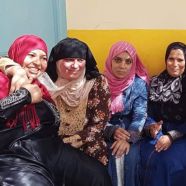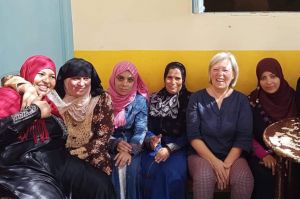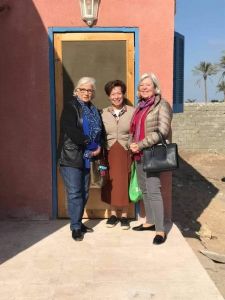The Mansouria Story
The vet in his white coat and I stood waiting in the empty dirt street for the village women to come out of their mud-brick houses with their chickens. One of the local girls we’d trained, Nermine, stood by with a loudspeaker, calling out to the women to bring their poultry to be vaccinated. This was during the height of the bird flu in Egypt in 2006. But the villagers were suspicious, they thought we might kill their chickens. No one came out.
As I watched the winter sun lower itself behind the palm trees, I wondered what I was doing standing there in the dirt street of the Mansouria village. It all began about twenty years ago, when a bunch of Cairenes like myself decided to move to this rural area about twenty kilometers west of Cairo to escape the hustle and bustle of the city and to enjoy the clear skies, open spaces, and general benefits of living in the countryside. But as we designed our airy new houses—I am an architect by profession—and landscaped our lawns and gardens, we became uncomfortably aware of the shocking disparity between our lifestyle and that of the local population in terms of education, outlook, and financial resources. It became unacceptable to the transplants from Cairo that we should enjoy the benefits of this rural area without sharing some of our good fortune with its underprivileged residents.
Fifteen of us Cairo women got together and decided to start a nongovernmental organization (NGO) to bring much-needed services to the area. These included education, as a first priority, as well as health awareness, environmental protection, and safety measures. We rented a three-room flat, hired a local girl as our receptionist cum secretary, and launched our initiative. Word of mouth made the group grow very quickly, and the most important thing was that the members were willing not only to donate financially but also to volunteer their time and effort.
The first project we undertook was setting up a playgroup for the children. The same kids we were used to seeing on the street, dressed in tatters and walking barefoot, with flies covering their faces, came to the playgroup in their Friday best and sat happily enjoying drawing and coloring. This was one of the ways we were able to attract the parents and get them to tell us what they wanted to change in their community. The majority wanted to educate their children properly. Next they wanted to find a way to get rid of the garbage that they had no place to dispose of except by throwing it into the irrigation canals.
Education
To respond to the need for a better education, we rented the whole house where we had our NGO’s office, moved our office to the upper floor, transformed the flat roof into a playground, and furnished the middle floor as a kindergarten school for four to six year olds. The teachers were recruited among local girls who had some education and were then trained extensively by us to serve in the kindergarten. The applications to enroll children in the kindergarten were much more than we could accommodate, so we promised the parents that if we were successful the first year, we would start up more kindergartens and accept more children the following year. Today, we have four kindergartens serving 350 kids and two others that are supervised by our members and run by our former kindergarten teachers serving another 120 kids.
We discovered how important these kindergartens were when we started asking the kids simple questions. What is the color of the sky? What is the name of your country? What animal gives us milk? As simple as these questions are to answer, the responses from the kids were surrealistic. A red sky with a yellow tree and blue plants growing under the tree. Milk comes from the gray bottle on the milkman’s bicycle and my country may be Aqabawy, which is the village’s name. Have you heard of Egypt? Not really. Which is a circle and which is a square? Dunno. And so on.
To make the utmost use of these kindergartens, we thought they should be multipurpose service centers. In the morning they served as kindergartens, and in the afternoon, elementary schoolchildren came in for tutoring on the lessons they had been given in their public schools in the morning.
Although public schools in Egypt are supposed to be free for all, Egypt is a poor country, and the education budget does not meet the requirements of educating the large number of children enrolled in these schools. There are not enough teachers and not enough schools. Student numbers in a public school class range between 80 and 120 kids. What can one teacher do? Just keeping order in such a dense situation is challenging enough, let alone imparting some useful information. Kids learn very little and most of them graduate elementary school without knowing how to read or write. The regulations do not allow for students to repeat a year since a new class is waiting to take their place in the coming year.
Education, education, education. As important as it is, is this the only thing in life? Don’t these children need to play sports, draw and color, and make craft projects? Of course they do, and so on Saturdays, these multipurpose centers open their doors so kids can participate in these fun activities—both indoors and out. It is so gratifying to see a child hold a pair of scissors for the first time and gingerly cut colored paper and stick it on a sheet of construction paper and then go home with it, to proudly show off her artistry to her family. Drawing something on a paper plate, or making a picture frame with some twigs, these are simple ideas that cost next to nothing but bring great happiness to these children.
Adult Literacy
We also found that the rate of adult literacy was very low, especially among women. Men tended to attend literacy classes as a prerequisite for acquiring a driving license so the rate of illiteracy among men was a bit better than among women. But the women were so eager to learn. How did we tackle this need? One of our members was driving on the long dirt road leading to our NGO’s office and stopped to give a lift to a couple of girls walking by. The conversation drifted to a local girl, Hoda Gomaa, who had been trying to help them learn to read and write. We made an appointment to meet that girl, who turned out to be a beautiful, wide-eyed, ambitious young woman in her late twenties. She arrived for the meeting ahead of time and was already sitting at the table when we came in. After we had agreed on how to start the literacy lessons, she got up to leave and we were shocked to see that she was club-footed in both legs and could hardly walk. The amazing thing about Hoda is that her disability did not affect her love of life and her happiness in being able to help others.
Hoda Gomaa energetically recruited young, educated people to give literacy lessons in several nearby hamlets under her supervision, and the first steps toward eradicating illiteracy started.
Many of the literacy facilitators, though, wanted to prove that they had done a good job, so we noticed that during the interim tests they would help the students with their tests, thereby making the results unreliable and not reflective of the true standard of the learning. That was a lesson learned. During the final tests, even though supervisors from the Adult Literacy Organization, the governmental entity that gives out the literacy certificates, were on hand, we ourselves also had to be there to stop the teachers from helping the students complete their tests. Although we all wanted what was best for the students, we understood it must be done the right way.
Garbage Collection
Garbage and what to do with it was the next priority we tackled. In Egypt those who collect garbage from homes are called the Zabaleen. They make their living from collecting and selling recyclables. In the impoverished countryside, there is not much to recycle in the garbage. It is made up mainly of used and reused plastic bags, dust, used and reused paper, very little food remains, and so forth. But the quantities are large due to the density of people living in the little hamlets. Since the Zabaleen don’t benefit from this garbage, they refuse to take it.
Our solution was to get the government agency, the Organization for Cleanliness and Beautification, to set up a system in three hamlets. With pressure from the governor of Giza at the time, they agreed, although not very happily, to provide large bins and arranged for trucks to empty them twice weekly. The villagers started using the bins and the trucks came for the first month and then they stopped coming. It was not worth their while since the truckers also relied on selling the collected garbage and there was nothing to sell from our impoverished area.
Next we tried private entrepreneurship. We contracted with a man with a truck to collect the garbage both from the hamlets and from the Cairenes’ homes, charging us Cairo transplants more to cover the cost of garbage collection from the hamlets as well, whose residents would pay only a nominal fee. The guy with the truck did a decent job and then at the end of the month he asked the beneficiaries of his services to pay the amount they had agreed to pay. Both the Cairo people and the villagers gave us a hard time! One villager, who was relatively well off, would not pay. He claimed he did not throw out any garbage. After investigation, it turned out that he and his family, who lived in a five-room house, actually used one of the rooms as a garbage room, putting their garbage there and living with it and enduring the smells and germs, just to avoid paying the 30 cent fee required for collection. Strange people do exist! Garbage collection continues now, with another trucker, and it is making a noticeable difference in the places we serve.
Disabilities
One morning a young mother came in with her little boy who had Down Syndrome. She was in tears, saying she had been to so many doctors to cure him and they had given her so many medications for him but he hadn’t been cured. We realized that this was an area we needed to intervene in and to offer honest advice about how she and others like her could deal with their disabled children’s conditions. We met with our workers, teachers, and others to find out the scale of the problem in our area. We found out that disabilities were considered a shameful stigma by the villagers. They hid the existence of their disabled family members, often never allowing them out of the house, never letting them experience the sunshine.
We reached out to a well-established NGO, Caritas, which trains other NGOs to use a system called Community-Based Rehabilitation (CBR). This program trains local people who might not be qualified in that field to help families understand how to deal with disabled family members. Training took months and months and included a door-to-door field survey to identify homes with disabled members. The numbers that came out of this survey were horrific and the cases were heartbreaking. One twenty-three-year-old girl did not speak, could not groom or feed herself, and had never left the house. A young man whose mother had to go out to work was chained to the stairs so that he would not stray out of the house and get lost and abused. A mother was told her son was autistic and the word for autistic in Arabic sounds like “alone,” so she kept him locked up alone never seeing anyone else except her. Ignorance was rampant. Families were suffering and had no way of understanding how to help themselves or their disabled kin lead active lives.
After the initial training, our facilitators, usually young women, started working with the mothers, listening to their problems and guiding them step-by-step in how to respond using the proper and correct techniques. The disabled individuals would come in twice a week with their families to join in academic and vocational activities under the watchful eyes of the trainers. The rest of the week they would be under the care of their now more knowledgable and more relaxed family members who had been taught how to respond to their needs in nurturing, informed, and supportive ways.
The mothers of these children have now formed their own support group and have become great friends. They look forward to the two days they spend with our program and help each other with problems and emergencies if the need arises. Once a year, mothers and children go on a trip where they share in cooking nice meals for each other and enjoy a happy day doing something different, something they never imagined they would or could do with their children.
Vaccinations
I reminded myself of these challenges and successes as I stood there in the empty dirt street with the vet and the girl with the bullhorn. Finally, just as we were about to give up, just before sunset, the village women trickled out, carrying their chickens, ducks, and geese tucked under their arms. And so, amid cackling birds and apprehensive women, the job got done and all the poultry in at least one village in Mansouria were properly vaccinated.











Excellent article about wonderful dedicated ladies lending a helping hand to those who really need it. Kudos to all of you ladies and a special bravo to my cousin Inas Omar. Keep up the good work👏👏
What an inspiring story! Such dedication and loyalty in a much needed area! I got misty ready this article about invisible areas in our beloved country. Thank you to all those brave women and thanks Samia for publishing it.
Thank you Maggie for taking the time to read my long article
What an inspiring story! Such dedication and loyalty in a much needed area! I got misty reading this article about invisible areas in our beloved country. Thank you to all those brave women and thanks Samia for publishing it.
مبادره حقيقيه واصيله للعمل الاجتماعي كما يجب ان يكون وعاصرتها من مده طويله وتابعت تطورها واخلاص أعضائها ، ايناس خير مثال بالنسبه لى فى العمل الاجتماعي والتركيز على الأطفال هو المطلوب لنهضه مصر كلها وليس فقط المنصوريه ، والثقه فيما تقومون بإنجازه دافع قوى لمن يريد المساهمه لانها تصل الى المتلقّى فورا وتطهر نتائجها باستمرار ، شابوه لكم جميعا على اقتحامهم للجهل والاميه والمشاريع الصغيره
Thank you dear Hamida. Without your support and the good people like you none of this could have happened
Thank you Maggie for taking the time to read my long article